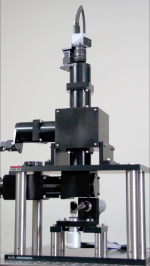July 15, 2012 report
1ms pan-tilt camera system tracks the flying balls (w/ Video)

(Phys.org) -- University of Japan researchers have worked on a camera system that tracks fast-moving objects in realtime, automatically keeping fast moving objects centered. The system can track fast-moving objects with high accuracy, called “amazing.” A video demo has been made that reveals their success. This is a pan-tilt system that keeps an object at the center of the field. The researchers started work based on a challenge they recognized in the broadcast of major sports events such as the World Cup and games at the Olympics, where videos that are powerful and of the highest quality are in demand.
In reality, though, they call attention to a number of limitations in techniques being used to capture the games. “It is often hard for camera operators to keep tracking their camera's direction on a dynamic object,” they wrote, such as the player or the ball. Shooting has been limited either to moving the camera’ gaze slowly with a wide angle of view or inaccurately controlling the gaze. “Super slow and close-up videos of the remarkable player or the ball are thought to be especially quite valuable. However, camera operators have not been able to do that.”
Carrying out their work at Ishikawa Oku Laboratory, the team worked out a camera system that can track fast-moving objects with something described as a high-speed gaze control device Two mirrors, one pan, one tilt, can move sixty degrees in approximately 3.5 milliseconds. These mirrors do the tracking realtime, bouncing images back to a stationary high-speed camera. The 1ms Auto Pan-Tilt system, as the system is named, gets its 1ms designation because it uses a 1,000 frame-per-second vision targeting system. Mirrors react to changes in the subject’s speed or trajectory in no more than 3.5 milliseconds, which is the amount of time required for either of them to move a full 60 degrees, their panning and tilting limit.
Their work does not signify a first in pant-tilt camera systems development. The researchers do, however, spell out where their work has an edge. “To control the camera's gaze with millisecond order in real time is difficult. The main reason is the method of controlling the gaze. A general pan/tilt camera is mounted on a rotational base with two-axis actuators. The actuators must control both the base and the camera. For millisecond-order control, the weight of the rotating parts must be reduced as much as possible”. In their method, the camera is fixed and their gaze-control device using rotational mirrors is installed next to the camera, controlling the camera's gaze with use of the two mirrors.

An easily predictable application would, as the researchers suggest, be for use in televised sports, where the camera used in the system shoots in full HD at 500 frames per second. Another application could be for science research in shooting fast-moving objects such as birds, insects, or aircraft.
Team members behind the development are Kohei Okumura, Hiromasa Oku and Masatoshi Ishikawa.
More information: www.k2.t.u-tokyo.ac.jp/mvf/Sac … rFullHD/index-e.html
© 2012 Phys.org





















